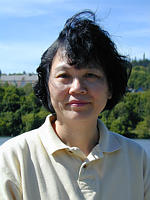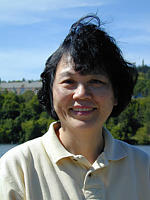
|

|
| without a UV filter | with a UV filter |
| Click on the image to see a larger one | |
Remember that films and the CCDs behind your camera lens are sensitive to ultra-violet (i.e.. UV) rays, although they are invisible to our eyes. If you allow UV light to be recorded on the CCD, it is likely that your image will look bluish and the color casts may not be acceptable. Moreover, UV and skylight type filters can also eliminate the lack of sharpness caused by UV radiation and reduces distant haze. UV and skylight filters are design to remove UV light (to some extend) and the bluish cast. UV filters are colorless and skylight filters are pinkish. Both filters can effectively remove UV light; however, skylight filters may produce warmish images because of their pinkish cast.
Excessive bluishness frequently occurs in outdoor photography, especially in open shade under a clear, blue sky and near water front. The following shows an example. The left image was taken without a UV filter, and, the right one is taken with a UV filter.

|

|
| without a UV filter | with a UV filter |
| Click on the image to see a larger one | |
UV filters absorb UV light and are clear glasses. Skylight filters are colored glasses and usually have a touch of pink. In addition to absorbing UV light, the pinkish color of a Skylight filter can also counter the excessive blue color of the sky in a sunny day, and produce a warmish tone.
Haze is caused by dust particles in the air. These particles reflect shorter wavelengths more than the longer ones. Thus, UV is affected the most, followed by blue, followed by green and red, and the recorded images will be not very sharp and look hazy. Haze filters are designed to reduce haze and are yellowish to counter the excessive blue. For example, Tiffen Haze 1 reduces excess blue and transmits 29% at 400mm wavelength, while Tiffen Haze 2A provides greater ultra-violet correction than Haze 1 and transmits 0% at 400mm wavelength. However, for color photography, polarizers are frequently used. Note that although polarizers many not cut through haze as effectively as Haze filters do, polarizer can increase the contrast of the scene by eliminating reflection!
The following is a simple comparison of various UV, Skylight and Haze filters. All images were taken in a heavy hazy day. The original image is shown below. Then, for each filter, we take an image and the indicated rectangular portion is cut without editing.

|
| The original image |
| Click on the icon to see a larger image |
The filters used for this comparison include three types: UV - the most popular type, Skylight 1A and 1B, and Haze. Those UV filters available to me include B+W UV 010, Crystal Optic UV, Hoya UV(O), Marumi UV, Nikon 28mm UV that comes with Nikon Coolpak and Nikon L37C. Of these six, the Crystal Optic, Marumi, Nikon 28mm UV are very popular among Coolpix shooters and have a thread size of 28mm. The second type is Skylight 1A and 1B. The colored skylight filters can absorb UV light as well as providing a warm effect. The third type is the yellowish Haze 1 and Haze 2A filters. Finally, UV filters are not born equal. They produce slightly different results. From the image below, one sees that UV, skylight and Haze filters do increase contract, and the pinkish and yellowish color casts introduced by skylight and haze filters, respectively, are also obvious.